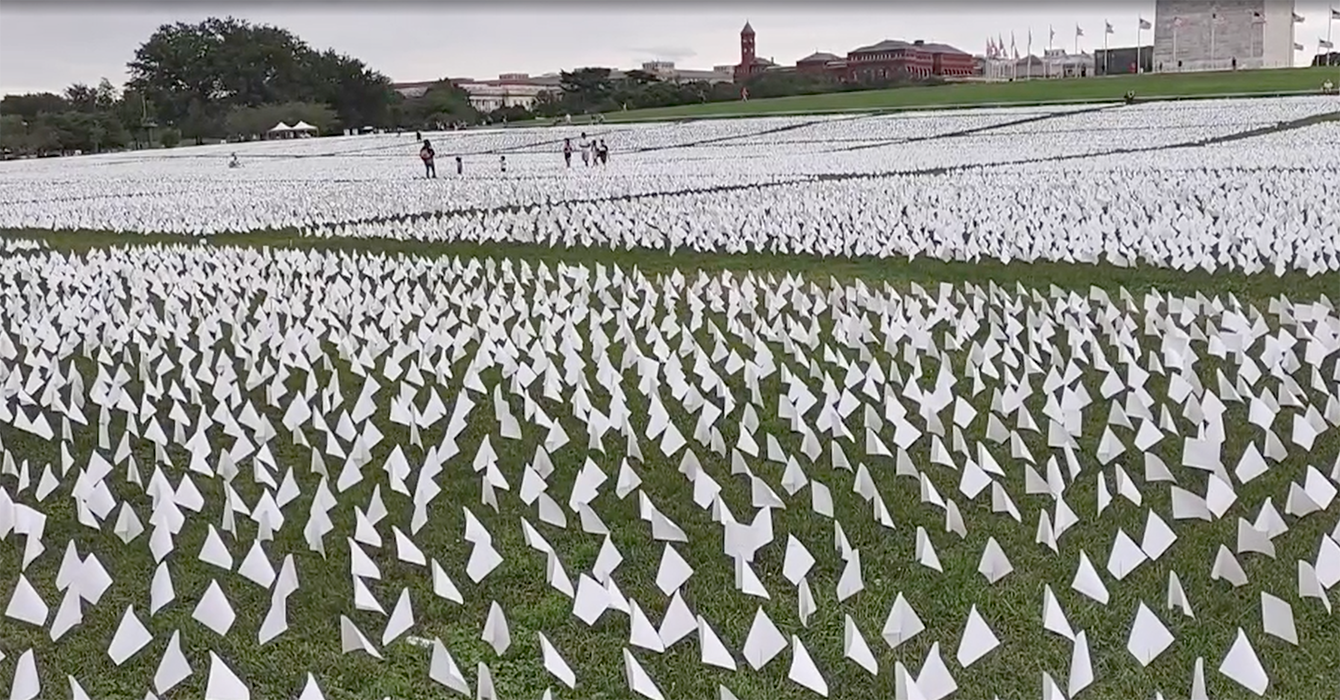Between the flags flapping in the wind and the traffic noise, the sound was deafening. Imagine an entire arena of people clapping out of sync intermingled with b-roll of big-city street traffic and pedestrian buzz.
On the day I visited the public art installation “In America: Remember,” there were 673,484 white flags planted on some 20 acres of the National Mall by the Washington Monument. The number of flags changed daily throughout the weeks-long exhibit, as did the count on a nearby sign, keeping track of American deaths from COVID-19.
Thousands of people walked among the flags, some stopping to write names, prayers, remembrances and goodbyes as they soaked up the gravity of their surroundings. The number of deaths climbed so quickly that additional sections of the exhibit had to be added.
The visual effect was baffling. The grief was palpable.
Artist Suzanne Brennan Firstenberg was inspired to create the installation upon hearing some say that COVID-19 deaths are just a statistic. She felt compelled to help people see what is happening in front of them.
As a former retirement community chaplain, I recognize Firstenberg’s desire immediately. In the face of death, we long for rituals and traditions that help us make meaning in our grief.
This is supposed to be in the wheelhouse of the church. I’m hesitant to say that the church “does grief well” — but we do.
Prior to this pandemic, even if someone didn’t go to church, a funeral home could arrange for a clergyperson to lead a memorial service.
Someone who hadn’t been to church in 50 years could still have a funeral hosted in a sanctuary with a pastor offering kind words, favorite Bible verses and comforting assurances of resurrection.
Memorial, remembrance and graveside services are important opportunities for churches to host their community as they love God and love their neighbor. When a loved one dies, being in community distributes the burden of loss and amplifies expressions of love.
Church hospitality committees would fill fellowship halls with an abundance of chicken salad sandwiches, cheese balls, cookies and punch following a funeral. The dedicated volunteers knew that loved ones and long-lost friends would be driving several hours for a 30-minute service. Those mourners would still be sad when they left, but they would not leave hungry.
In our retelling of the story of the life, death and resurrection of Jesus Christ, the church offers shared hope and comfort to the bereft. And yet the church’s ability to “do grieving well” in the last 20 months has been severely stunted.
When a loved one dies, being in community distributes the burden of loss and amplifies expressions of love.
Funerals and memorials have moved online, which is a valiant effort and may be the safest option for some form of ritual for now. Platforms like Zoom have certainly opened options to attend services for those far away who otherwise could not. And I’ve heard from many with hearing challenges who appreciate online services because they can adjust the volume on their devices.
“But it isn’t the same,” a grieving friend said recently. “It felt flat, like we were just going through the motions because we needed to do ‘something.’ I guess it’s better than nothing.”
Better than nothing. Ouch.
It is not the church’s fault. No one wants the faith community to be the next COVID-19 hot spot. We are cautious, guarded, separate, masked — whatever it is our health and community leaders deem necessary at the time. Meanwhile, as deaths continue to mount, the accompanying grief lingers unassuaged, because it is not safe for the church to fully embody the rituals and traditions that, when in-person, bring the community together, enact the sharing of burdens and help us find meaning in grief.
Consider what it means when a public event like the art exhibit is needed to help the country grieve and make sense of what is happening around us. Think about the implications of our nation’s capital hosting a mechanism for collective sorrow, when the church, an already fragile institution in the midst of significant transition, has not been able to fulfill one of its primary wheelhouse duties.
Would the eventual 700,000-plus flags have made as powerful an impact if the majority of those represented had been remembered in traditional church services and buried with loved ones and lifelong friends gathered around their final resting places?
Unfortunately, for many of our churches in the last 25 years (save the last two), a funeral crowd fills the pews more fully than any given Sunday worship service. Friends and family who haven’t been seen in years show up to pay their respects and be present in traditional rituals of bereavement.
In this season, when that isn’t happening in a way that satiates our need to gather and grieve, the void we feel in all that we have lost grows deeper.
We know that nature abhors a vacuum. Science, communities, families and organizations do not tolerate a void for long. Out of desire for homeostasis, it will be filled with something, regardless of whether that is anything like what was previously there.
In doing what feels medically, socially and theologically responsible, our collective grief has compounded and created a deep void of closure.
Will the church be able to reclaim its place in the void? The road back to what used to be is likely too far gone. So what is next? There are other institutions standing in the gap waiting to step in and fill the void, regardless of what was previously there. How might the church create new expressions of hosting rituals and traditions to regain its role as a place of solace and hope?



















